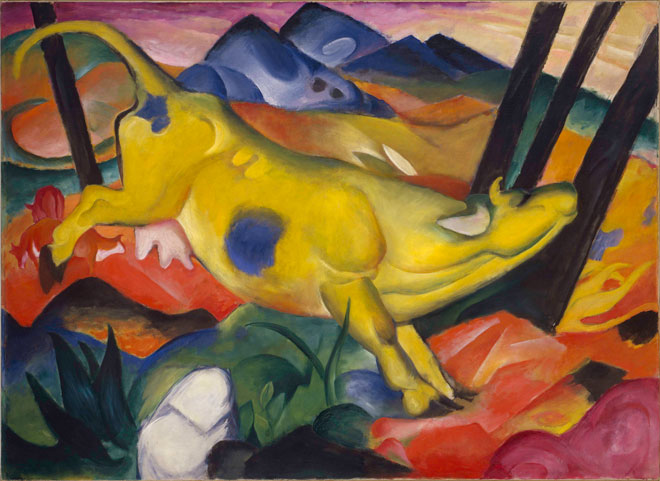images from ago.net
Currently on at the AGO is The Great Upheaval: Modern Art from the Guggenheim Collection. I got the chance to see it last Friday. Full disclosure, it was for school. I'm required to write and exhibition review for my art writing workshop, and the review I write will likely be the first of my art show reviews to be read by someone who does this stuff professionally. I figured I'd feel a bit more comfortable starting out here.
On to the show. In most senses, I knew what to expect. I've studied work from this period before and understood the basic principles of the movements represented (Cubism, Fauvism, Dada, and Der Bleue Reiter). What I was really looking for, as a student of art criticism and curatorial practice, was to understand how and why the show was put together. Why were certain pieces hung in the places they were? What impact did the text on the walls have on my understanding of the show? I didn't just want to look at the artworks, I wanted to understand them both in their historical context and in the context of here and now - myself, the Guggenheim, and the AGO.
The show was laid out chronologically, beginning with the "precursors" and moving toward innovation and war. The rooms, leading one into the next, were quite spare. Large (and some not so large) works were given room to breathe, and the space left room for consideration about why certain pieces were placed together. For example, works by Mondrian, Delaunay, Kandinsky, and Picasso were placed together in a square, seemingly in conversation with one another. Despite the artists' different approaches to colour, they all featured similar approaches to linework. Shown together, it was easy to see how his trend in art-making was used by different artists, across countries and movements.
The "branding" of the show - red, black, and white, a bold sans serif typeface, and diagonal margin justification of the text was reminiscent of wartime European propaganda posters. Context to what was going on in both the art world and the world at large was provided, and didn't distract from the works themselves.
Moving on to the "war" area of the exhibition, I wasn't sure what to expect. Many artists served, so I thought perhaps we would see impressions of war. A small placard warned on entry that viewers would hear sounds of war - gunshots and explosions. I thought maybe there would be a screen showing newsreels or war footage but this was nowhere to be seen. I investigated the noise and found, zip-tied to the ceiling, two small speakers. Directly over the placard warning viewers of the sound was the source of it. I suppose this was used to "set the scene" as one entered the "war" section. I found it a little on-the-nose, but I shrugged and entered the space.
What I found most striking in this space was not images or impressions of the brutality of World War One. It was, incidentally, an installation of works dealing with the everyday by Braque, Modigliani, Van Doesburg, among others. Oils on canvas featured still lifes on kitchen tables - positively mundane in the midst of war brutality. I enjoyed the sensitivity in these works, and a picture into wartime domestic life.
The show ended with a projection in a narrow corridor - a quote by Einstein was projected on the floor: "The world cannot be changed without changing" - a nod, I would gather, to the changes wrought by the artists featured in the show. Indeed, the years leading up to the Great War were incredibly fruitful artistically, and the gravity of those changes and advancements were seen through to the fifties in America (I'm drawing a parallel here with Abstract Expressionism). I was given brief time to ponder the quote as I exited the show into the gift shop. How convenient - I could buy prints and reproduction canvases of the works I just saw! I could also buy high-end barware and $20 art-print socks! I did pickup an exhibition catalogue, beautifully printed and bound, for twenty bucks. Whatever my thoughts are on the placement of the gift shop, I'm sure they're irrelevant. It's a symbiotic relationship, I suppose - patrons support the gallery with their money and the gallery acts as a resource for cultural capital. I'm not going to end my discussion of the show on that note. I want to conclude by saying that it is always satisfying seeing works I've studied in school in the flesh. There is a certain magic in seeing close-up and in full scale the images from google searches and textbook thumbnails. The show was simply and sparely laid out. The work and artists were given a chance to speak for and with themselves, and to the experimentation and developments in art at the time.



If you wish to sell the catalogue when you have finished with it, I would be interested in buying it from you. murielli2@sympatico.ca
ReplyDelete